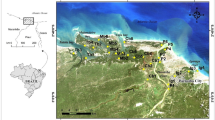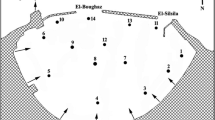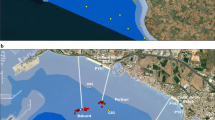Abstract
This work was carried out within the framework of a scientific investigation of the environmental condition of the Taparua project zone in Tunisia after the completion of the depollution activities. It deals with the evaluation of heavy metal contents in the subsurface of the artificial seabed sediment. The thermal decomposition, mercury amalgamation and atomic absorption results were rather comforting as the heavy metal rates were below the detection limit (Cr, Pb, Cu, Cd and Hg) or at most below the limits fixed by the local standards (Zn and Ni) except for some locations in or around the channels that connect to the beach (Ni). Thus, it is clear that the source of this contamination with Ni in specific locations is not from the quality of sediment used for the coast reclamation works but rather anthropic.




Similar content being viewed by others

References
Bakan G, Ozkoc HB (2007) An ecological risk assessment of the impact of heavy metals in surface sediments on biota from the mid-Black Sea coast of Turkey. Int J Environ Stud 64(I):45–57
Callaert B, Hentati R (2011) Sustainable development in the City of Sfax (Tunisia) - Taparura project. IWWG proceedings Sardinia, p p12
Chiffoleau J-F, Auger D, Chartier E (1999) Fluxes of selected trace metals from the seine estuary to the eastern English Channel during the period from august 1994 to July 1995. Cont Shelf Res 19:2063–2082
Dix HM (1981) Environmental pollution. Wiley, New York
Förstner U, Wittman G (1981) Metal pollution in the aquatic environment. Springer Verlag, Berlin Heidelberg, p 486
Gargouri D, Azri C, Serbaji MM, Jedoui Y, Montacer M (2011) Heavy metal concentrations in the surface marine sediments of Sfax Coast, Tunisia. Environ Monit Assess 175(1–4):519–530
Gouider M, Choura M (2013) Sfax City southern coast reclamation drawn on the Taparua project acquired know-how, proceedings of the 26th AFA international fertilizers technology conference, Tunisia P56
Hamza W, Cherif F, Choura M (April 2018) Exploration of the bearing capacity of Taparura Artificial Beach using the standard penetration test. J Coast Conserv 22(2):315–324
Hassaan MA, El Nemr A, Madkour FF (2016) Application of ozonation and UV assisted ozonation on decolorization of direct yellow 50 in sea water. TPCJ 3(2):131–138
Hidrotecnica Portuguesa (1995) Unpublished work, «Etude générale de protection du littoral tunisien contre l’érosion marine» Tunisian ministry of equipment and habitation V6 124–132
Jain CK, Sharma MK (2001) Distribution of trace metals in the Hindon River system, India. J Hydrol 253:81–90
Jörgensen LA, Pedersen B (1994) Trace metals in fish used for time trend analysis and as environmental indicators. Mar Pollut Bull 28:235–243
Laws EA (1945) Aquatic pollution, an introductory text. Wiley, New York
Maanan M (2008) Trace metal contamination of marine organisms from the Moroccan North Atlantic coastal environments. Environ Pollut 153(1):176–183
MacDonald DD, Ingersoll CG, Berger TA (2000) Development and evaluation of consensus-based sediment quality guideline for freshwater ecosystems. Arch Environ Contam Toxicol 39:20–31
Mendi V, Dwarakish GS (2015) Coastal pollution: a review. Aquatic Procedia 4:381–388. https://doi.org/10.1016/j.aqpro.2015.02.051
Tayibi H, Mo C, Lopez FA, Alguacil FJ, Lopez-Delgado A (2009) Environmental impact and management of phosphogypsum. J Environ Manag 90:2377–2386
Turki-Abdelhedi I, Ghorbel-Zouari S (2012) The Taparura project: how to sustainable development? IJEI 5(1):1–25
Wyles KJ, Pahl S, Thomas K, Thompson R (2015) Factors that can undermine the psychological benefits of coastal environments: exploring the effect of tidal state, presence, and type of litter. Environ Behav:1–32
Zhang J, Huang WW (1993) Dissolved trace metals in the Huanghe: the most turbid large river in the world. Water Res 27:1–8
Acknowledgements
This work was funded by the Company for Studies and Development of the Northern Coast of the City of Sfax (SEACNVS) as a holder of the Taparura project and assisted by the Tunisian Agency of Coastal Protection and Management.
Author information
Authors and Affiliations
Corresponding authors
Additional information
Publisher’s note
Springer Nature remains neutral with regard to jurisdictional claims in published maps and institutional affiliations.
Rights and permissions
About this article
Cite this article
Hamza, W., Hmid, R.B., Souissi, R. et al. Environmental assessment of the Taparura site seabed: a follow up of the sediment contamination as a route to sustainable coastal development in Tunisia. J Coast Conserv 23, 607–613 (2019). https://doi.org/10.1007/s11852-019-00691-1
Received:
Revised:
Accepted:
Published:
Issue Date:
DOI: https://doi.org/10.1007/s11852-019-00691-1



